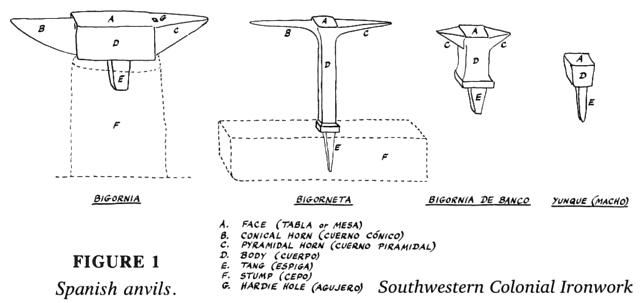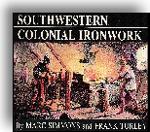Photos provided by Stefaan Meeus - Belgium.
From the Barcelona "Forja Viva" blacksmiths gathering.
Apart from being a great get-together of blacksmiths, they also seem to have a peculiar type of anvil, so I took a few pic's.
- Stefaan
 The Catalan anvils look somewhat like the French/Spanish/Italian style anvils (broad face compared to its height) without feet but with a "tail" (stake) instead to fix them into a wooden block.
The smallest one looked like 30 kg range, but the biggest (anvil nbr. 4, from 1924, in Guillermina Morales's workshop; Guille was the driving force behind this event) weighs 200 kg.
The last one weighs 97 kg. At least one anvil looked cast, a few of the others seemed to have a welded face and looked forged (like the last one). The most peculiar feature is the offset square horn (seen on all local anvils except the 200 kg and a smaller one).
Some anvils features a round an a square hole, others only a round hole.
I only saw a dog hole on the square horn side.
The Catalan anvils look somewhat like the French/Spanish/Italian style anvils (broad face compared to its height) without feet but with a "tail" (stake) instead to fix them into a wooden block.
The smallest one looked like 30 kg range, but the biggest (anvil nbr. 4, from 1924, in Guillermina Morales's workshop; Guille was the driving force behind this event) weighs 200 kg.
The last one weighs 97 kg. At least one anvil looked cast, a few of the others seemed to have a welded face and looked forged (like the last one). The most peculiar feature is the offset square horn (seen on all local anvils except the 200 kg and a smaller one).
Some anvils features a round an a square hole, others only a round hole.
I only saw a dog hole on the square horn side.
 Illustration from Southwestern Colonial Ironwork by Marc Simmons and Frank Turley.
Illustration from Southwestern Colonial Ironwork by Marc Simmons and Frank Turley.
Bigornia, Bigorneta, Bigornia de Banco, Yunque

Southwestern Colonial Ironwork
The spanish blacksmithing tradition from Texas to California. By Marc Simmons and Frank Turley
 Small Catalan Anvil
Small Catalan Anvil
From the Frank Turley Collection.




 Illustration from Southwestern Colonial Ironwork by Marc Simmons and Frank Turley.
Illustration from Southwestern Colonial Ironwork by Marc Simmons and Frank Turley.  Return to Misc and Donated Anvils Index
Return to Misc and Donated Anvils Index Anvil Collections Gallery Index
Anvil Collections Gallery Index
 The Catalan anvils look somewhat like the French/Spanish/Italian style anvils (broad face compared to its height) without feet but with a "tail" (stake) instead to fix them into a wooden block.
The smallest one looked like 30 kg range, but the biggest (anvil nbr. 4, from 1924, in Guillermina Morales's workshop; Guille was the driving force behind this event) weighs 200 kg.
The last one weighs 97 kg. At least one anvil looked cast, a few of the others seemed to have a welded face and looked forged (like the last one). The most peculiar feature is the offset square horn (seen on all local anvils except the 200 kg and a smaller one).
Some anvils features a round an a square hole, others only a round hole.
I only saw a dog hole on the square horn side.
The Catalan anvils look somewhat like the French/Spanish/Italian style anvils (broad face compared to its height) without feet but with a "tail" (stake) instead to fix them into a wooden block.
The smallest one looked like 30 kg range, but the biggest (anvil nbr. 4, from 1924, in Guillermina Morales's workshop; Guille was the driving force behind this event) weighs 200 kg.
The last one weighs 97 kg. At least one anvil looked cast, a few of the others seemed to have a welded face and looked forged (like the last one). The most peculiar feature is the offset square horn (seen on all local anvils except the 200 kg and a smaller one).
Some anvils features a round an a square hole, others only a round hole.
I only saw a dog hole on the square horn side.

